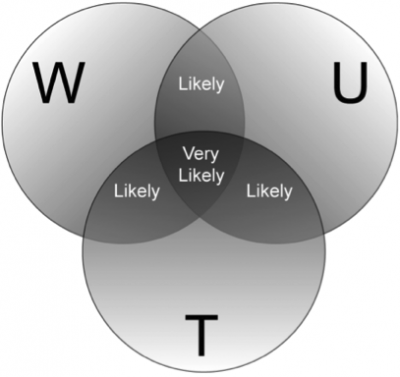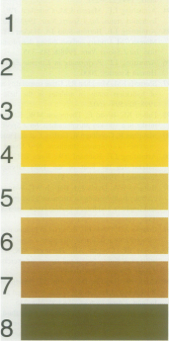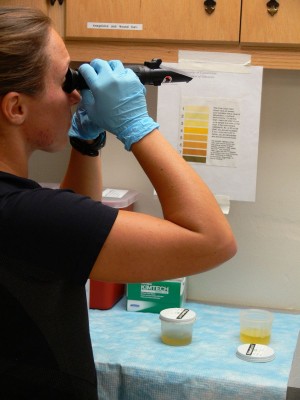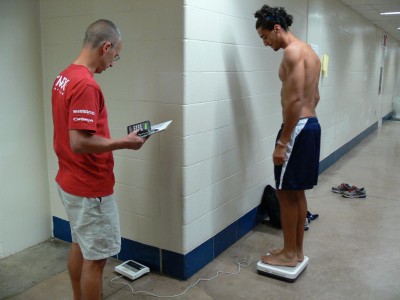Monitoring hydration status before, during and after exercise is essential for both performance and safety during physical activity. Maintaining an appropriate level of hydration (a euhydrated state) has been shown to increase performance (aerobic exercise, anaerobic exercise, strength, power), allows athletes to exercise at lower body temperatures and heart rates, improves cognitive function, and has been shown to enhance immunological function.
Dehydration is influenced by exercise intensity, environmental conditions (temperature and humidity), and availability of fluids during exercise. Once an individual loses 2% of their body mass from fluid losses impairments in performance are noticeable and these impairments become more extreme with greater levels of dehydration. Also, it has been shown that with increasing levels of dehydration body temperature and heart rate increases over and above the levels of someone who is hydrated, which can increase the risk of heat illness in dehydrated exercising individuals.
An appropriate hydration strategy involves athletes to begin exercise hydrated, minimize fluid losses during exercise, and then replace fluid losses after exercise. Hydration needs are individualistic, so athletes should be aware of their own hydration needs to maximize performance and safety.
blank
How Do I Know I am Hydrated?
There are various modes in which hydration status can be measured, but unfortunately, there is no consensus as to which method is the best in terms of assessing an individual’s hydration status. Also, since an individual’s total body water content fluctuates constantly throughout the day, it is difficult to know what level is of total body water is a euhydrated state. Although there is no consensus as to which methods of hydration assessment are best, here are a few methods that can be used to measure hydration status.
Presently there is no scientific consensus regarding the best method to assess hydration status nor is there a normal “total body water” value to represent euhydration. Nonetheless the following measures have been and can be used to assess hydration status:
- Urine Color – Urine color can be assessed and compared with the urine color chart (as seen to the right). This is the easiest measure of hydration for most people because it is easy to assess and does not need additional equipment to do so. The higher the number or darker the color the greater degree of dehydration. Urine color 4 or greater indicates dehydration.
- Urine Specific Gravity (USG) / Osmolality (UOsmol)
- Sensation of Thirst – Thirst develops once dehydration has already set in (~1-2% of body mass loss) and is considered to work best during rest or exercising at lower intensities for less than one hour in cooler conditions.
-
- Sensation of thirst works well only at rest
- Blood Measures – Measuring plasma osmolality, plasma volume, hematocrit concentrations, and hemoglobin can determine the level of hydration/dehydration. Due to the invasive nature of this measure, it is not recommended in the athletics setting.
 Cheuvront S, Sawka M. Hydration assessment of athletes. Sports Sci Exchange 18: 1-6, 2005.
Cheuvront S, Sawka M. Hydration assessment of athletes. Sports Sci Exchange 18: 1-6, 2005.
As seen in the Venn diagram above not one biomarker of hydration (weight, urine, and thirst), provides enough evidence of dehydration; however, the combination of any two simple self-assessment markers means dehydration is likely, and the presence of all three makes dehydration very likely.
How Do I Know How Much Fluid to Drink During Exercise?
Fluid needs for athletes are specific to the athletes themselves due to the variability in sweat rates amongst people. The best way to know how much fluid to drink during exercise is to calculate your sweat rate to know how much fluid you are losing during activity. After sweat rate is calculated you can calculate how much you need to drink.
To get the most accurate sweat rate, the following steps should be followed:
- Before the workout, ensure the athlete is hydrated (light colored urine). Being dehydrated will affect normal sweat rate.
- Take a nude body weight before the workout.
- Exercise for one hour (type and intensity of exercise should be similar to the conditions in which knowledge of sweat rate is needed).
- During the one hour workout refrain from drinking fluids as this will affect sweat rate. If water is consumed, weigh the water before and after the workout to determine the difference.
- After the workout take another nude body weight and calculate the difference between pre and post exercise. If water is consumed during exercise subtract the water weight from the post exercise weight.
- Every 2.2 pounds a person loses equates to 1 liter of fluid loss (sweat loss). For example, if someone loses 5 pounds in 1 hour their sweat rate is 5/2.2 = 2.27 liters/hour.
- A person’s sweat rate is the amount of fluid they should aim to replace during exercise. For heavy sweaters it is not uncommon to be unable to drink everything they lose during the workout. Full replacement of fluid losses may not be able to occur until after exercise.
If it is not possible to exercise for a full hour, the following equation can be used to calculate sweat rate:
[(pre exercise bodyweight – post exercise bodyweight) + fluid intake – urine volume ]/exercise time in hours
After your sweat rate is calculated you will know your fluid needs during exercise. The goal is to minimize fluid losses (try to keep body mass losses <2%). For people with high sweat rates (> 2 Liters per hour) it will be difficult to replace all fluids during exercise because the stomach only absorbs ~1.2 Liters per hour. By minimizing fluid losses during exercise you will end exercise more hydrated, thus helping to maximize performance.
How Much Do I Need to Drink After Exercise?
Rehydration should occur within 2 hours post exercise to assure optimal rehydration. Post exercise rehydration should be 150% of body mass loss during exercise. Use this calculation to adequately replace fluid post exercise, following the guidelines stated previously
Pre exercise wt (kg) – post exercise wt (kg) x 1.5 = Fluid Needs for Replacement per ACSM Guidelines
For every 1 kg (2.2 lb) loss, additional 1 L of fluid needed:
|
Fluid Replacement After Exercise |
|
|
BM loss |
Fluid Needed |
|
0.5 kg (1.1 lbs) |
0.5 L |
|
1 kg (2.2 lbs) |
1 L |
|
1.5 kg (3.3 lbs) |
1.5 L |
|
2 kg (4.4 lbs) |
2 L |
|
2.5 kg (5.5 lbs) |
2.5 L |
|
3 kg (6.6lbs) |
3 L |
Hydration Kit
The American College of Sports Medicine (ACSM) and the National Athletic Trainers Association (NATA) recommend athletes attempt to drink fluids according to the amount lost by sweat. Since sweat rate differs for each individual (based on acclimatization level, fitness, gender, protective equipment, etc.) and can range from about one liter per hour to as much as three liters per hour, it is difficult to suggest a fluid intake to satisfy everyone’s needs. The rule-of-thumb is for athletes to consume about 200-300ml of fluid every 15 minutes during exercise. This is enough fluid to replace an individual with one liter per hour sweat rate, however an athlete who drank this amount during practice and had a higher sweat rate would still become dehydrated over time, which is why a universal recommendation is difficult.
The first step to ensure athletes do not become dehydrated is to have the proper supplies in place. The following are KSI-suggested items to have on hand to promote hydration during sports activities. Names of common brands and retailers are provided as examples, however this is not an exhaustive list by any means. Prices are approximate and many providers offer discounted rates for large orders.
| Product | Price | Lifespan | Practicality | Purchasing |
| Pumper style hydration station | 20 gallon cooler, six hoses ~$900-$1,500 | Reusable – will require cleaning | This product holds 20 gallons of water, is very portable and easily refillable. This product is only an example of the different hydration units. Requires 12 volt-12 Amp battery, charges externally (battery & charger included) | Cramer ThermoFlo |
| Medco-Athletics Option 1 | ||||
| Medco-Athletics Option 2 | ||||
| Coolers | 3 gallons ~$25 | Reusable – will require washing | This product can be used to hold water, electrolyte drink and ice for rehydration and injury purposes. | |
| 5 gallons ~$25 | Gatorade | |||
| 7 gallons ~$45 | Rubbermaid | |||
| 10 gallons ~$55 | ||||
| Squeeze water bottles | 100 bottles – $160 | Reusable – will require washing (dishwasher safe) | This product can hold up to 32oz of fluid and ice. They can easily squirt into the mouth so it never has to touch the lips if they are shared. | Gatorade |
| Water bottle holder | ~$13-30 | Reusable | This product can hold up to 6 squeeze water bottles | Gatorade |
| Instant Electrolyte Drink Mix Powder | 1 case is 14 bags with 6 gallons each) | One time use per package (makes 6 gallons) | This product can make up to six gallons per package (84 gallons/case) and comes in a variety of flavors. | Gatorade |
| 1-12 cases – $110 | ||||
| 13-29 cases – $115 | ||||
| 30+ cases – $106 | ||||
| Waxed Paper Cups | 2,500 8oz cups – $68 | One time use per cup (reusable per person) | This product can be used for water or any kind of hydration beverage. These cups can last a whole game or for single use purposes. | Gatorade |
| Electrolyte Freezer Pops | 150 servings – $45 | 3 oz. serving | This product offers an electrolyte boost in a 3oz. serving size. “Just freeze it and sqweeze it” | Sqwincher Sqweeze |
| Hydration Kit | $160 | Will fuel a team of 20 for 10 games or practices | Includes 3 cases of Gatorade Prime (60 servings), 1 case Gatorade Perform (6 gallon powder- 84 gallons), 5 Cases Gatorade Recover (60 servings), and 60qt. ice chest on wheels or a 7-gallon cooler as well as your choice of 10 Gatorade towels or 12 Squeeze bottles with 2 carriers or 1 case of 8oz. cups (2,500 per case) | Gatorade |
| Hydration Kit | $215 | Will fuel a team of 25 for 22 games or practices | Includes 3 cases of Gatorade Perform (6 gallon powder- 252 total gallons), and your choice of three of the following: 10 gallon cooler, 7 gallon cooler, 60qt. ice check on wheels, 10 Gatorade towels, 24 squeeze bottles with 4 carriers, or 1 case of 8oz cups (2,500 per case) | Gatorade |
| Hydration Kit | $75 | Use for replenishment of inventory | Includes 1 case of Gatorade Perform (6 gallon powder- 84 gallons total), and 1 case of 8oz. cups (2,500 per case) | Gatorade |
Are Sports Drinks Better Than Water for Hydration?
- Intense endurance exercise, especially in the heat leads to both dehydration and depletion of glucose and electrolytes. Fluid-energy-electrolyte replacement beverages (i.e., sports drinks) improve endurance because they satisfy these needs, particularly in hot and humid environments with exercise lasting over one hour. Electrolytes also stimulate thirst and promote absorption in the gastrointestinal (GI) tract.
- Any fluid deficit that is incurred during one exercise session can potentially compromise the next exercise session if adequate fluid replacement does not occur. Therefore, it is important to replace fluid and electrolyte losses, and replenish energy stores in order to achieve recovery before the next bout of exercise.
- Both the volume of the drink and its composition are critical. Carbohydrates improve the rate of intestinal uptake of sodium, which in turn favors the retention of water. When proper hydration status is maintained, including carbohydrates in the sports drink delays the onset of fatigue during a the next bout of intense exercise in a warm environment. Even modest (up to 2% of body weight) exercise-induced dehydration decreases aerobic performance capacity and compromises cognitive capability.
- For people who are “salty sweaters” adding more sodium to a persons diet is beneficial: added sodium can take place during meals as well as during exercise by adding extra salt to a sports drink (although most athletes do not enjoy the taste of added salt to a sports drink).
- Although sports drinks have carbohydrates and electrolytes that can help during long exercise sessions, water is the best fluid to drink when exercise sessions are less than one hour. There is no added benefit of a sports drink during these short sessions since the body does not lose the amount of electrolytes that a sports drink would help mitigate. Also, the added sugar to one’s diet from drinking sports drinks could have potential long term health effects if they are the primary fluid source for a long period of time.
Recommendations for Concentration of Carbohydrates (CHO) in beverages
- 1 Liter of 6% CHO drink per 1 hour of exercise
- Do not consume >8% CHO concentration because it can lead to gastrointestinal distress
| INGREDIENTS | BEVERAGES | |
|
Sports Drink |
Water |
|
| Flavor | Has light flavoring that encourages people to drink more so they fully rehydrate. | Lack of flavor keeps you from drinking enough to fully rehydrate. |
| Carbohydrate | Contains carbohydrate to provide energy to working muscles so you can exercise longer. Absorbed by the body as quickly as water. | Provides no energy to enhance performance. |
| Electrolytes: Sodium and Potassium | Contains a small amount of sodium that encourages drinking and helps keep fluid in your system rather than losing it through the urine. Helps maintain sodium balance in blood. | Contains no sodium. Water stimulates kidneys to turn on urine production more than if you drank a sports drink with sodium. Does not replace electrolytes. |
Salt Loss
- Along with water, large sweat losses will lead to a loss of electrolytes, especially sodium and chloride.
- Failure to sufficiently replace sodium losses will prevent the return to euhydrated state and stimulate excessive urine production.
- Consuming sodium during the recovery period will help retain ingested fluids and help stimulate thirst.
- Drinks containing sodium such as sports beverages may be helpful, but many foods can supply the needed electrolytes.
Ergogenic aids and Supplements
- Caffeine: Little evidence to support the recommendations for exercising individuals to avoid caffeine.
- Glycerol: It is difficult to clarify whether hyperhydration with glycerol improves thermoregulation or decreases cardiovascular strain. However, in certain situations (such as the inability to consume large amounts of fluid during intense exercise in the heat or not having access to fluids), the use of pre exercise glycerol MAY assist with maintaining hydration status during exercise.
- Ephedra: There is insufficient evidence that ephedra can impair thermoregulation; however, the inability to conduct randomized controlled trials because of its potential negative effects may leave the effects of ephedra while exercising in the heat unknown. Furthermore, there have been sufficient case reports of deaths linked to ephedra to suggest ephedra is an unsafe supplement for athletes or other exercising individuals.
- Though more research is needed on the effects of particular supplements it is imperative to remain abreast of the most recent evidence regarding supplementation to better educate and advise athletes.
Do Young Athletes and Adults Need Different Hydration Strategies?
- Available data indicate that despite differences in sweating rates, pre pubescent athletes appear to incur similar levels of dehydration as adults.
- Thirst-driven drinking behavior as well as ad libitum (voluntary) fluid intake (as percentage of loss) appears to be similar between children and adults.
- Coaches and parents still need to take responsibility for enforcing fluid intake guidelines in young athletes because young athletes may not be aware of their actual fluid needs.
- Educating both young athletes and adults on proper hydration strategies that are individualized for themselves is important in maintaining overall health and performance during exercise.
What are the Benefits of Hydration?
Anaerobic Exercise
Endurance Exercise
Exercise in Heat
Power
Strength
Core Temperature
Heart Rate
Cognition
Mood
Immune Function
Sweat Rate
Beverage Temperature
References
- Brendon P. McDermott, Scott A. Anderson, Lawrence E. Armstrong, Douglas J. Casa, Samuel N. Cheuvront, Larry Cooper, W. Larry Kenney, Francis G. O’Connor, and William O. Roberts (2017) National Athletic Trainers’ Association Position Statement: Fluid Replacement for the Physically Active. Journal of Athletic Training: September 2017, Vol. 52, No. 9, pp. 877-895.
- Kenefick RW, Cheuvront SN. Hydration for recreational sport and physical activity. Nutr Rev. 2012;70:S137-S142.
- Lopez RM, Casa DJ. The influence of nutritional ergogenic aids on exercise heat tolerance and hydration status. Curr Sports Med Rep. 2009;8(4):192-199.
- Maughan RJ, Shirreffs SM. Dehydration and rehydration in competative sport. Scand J Med Sci Sports. 2010;20:40-47.
- Maughan RJ, Shirreffs SM. Development of individual hydration strategies for athletes. Int J Sport Nutr Exerc Metab. 2008;18(5):457-472.
- Rowland T. Fluid replacement requirements for child athletes. Sports Med. 2011;41(4):279-288.
- Sawka MN, Burke LM, Eichner ER, et al.. American College of Sports Medicine position stand: exercise and fluid replacement. Med Sci Sports Exerc. 2007;39:377-390.
- Shirreffs SM. Hydration: Special issues for playing football in warm and hot environments. Scand J Med Sci Sports. 2010;20:90-94.
- Shirreffs SM, Armstrong LE, Cheuvront SN. Fluid and electrolyte needs for preparation and recovery from training and competition. J Sports Sci. 2004;22:57-63.
- Casa DJ, Armstrong LE, Motain SJ, Rich B SE, Stone J. National Athletic Trainer’s Association Position State: Fluid Replacement for Athletes. Journal of Athletic Training. 2000; 35(2):212-224.
Page last modified on August 11th, 2019


